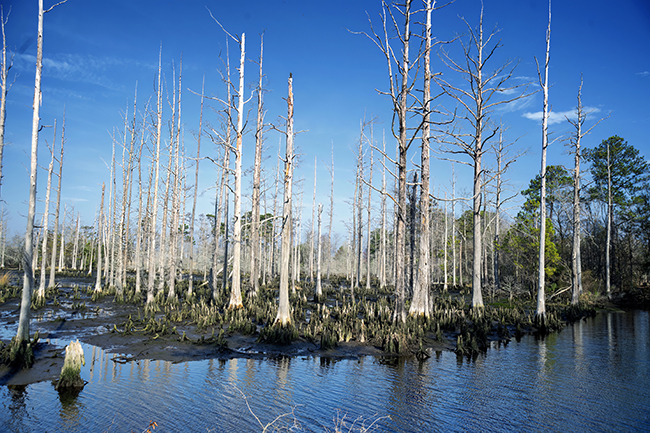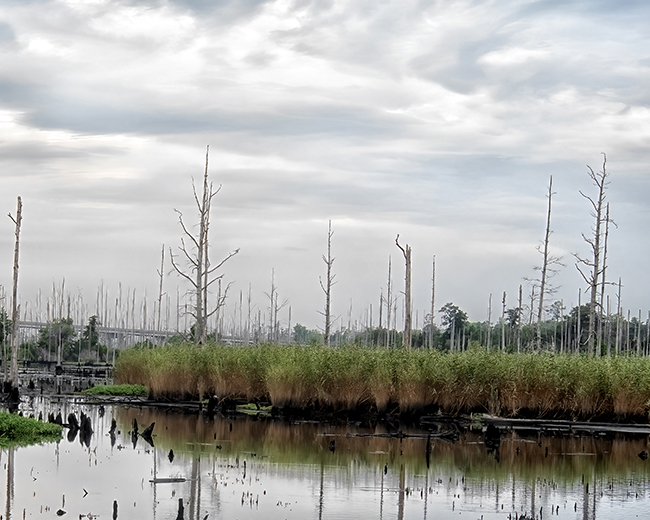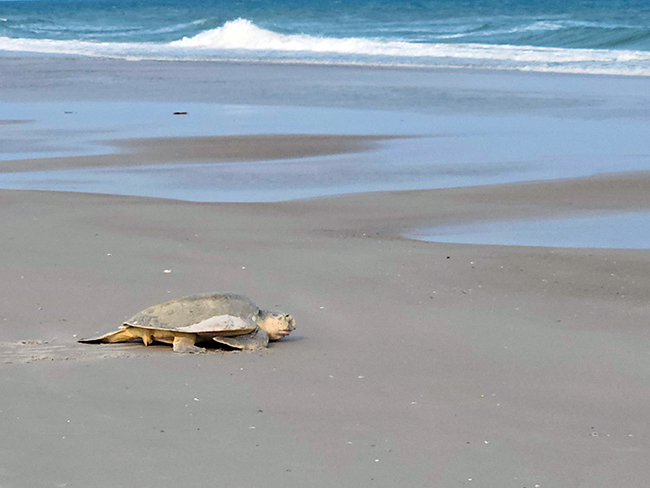Tide and Time on the Cape Fear
01 Jul 2025
A journey through the Cape Fear River’s past, from rice plantations to ghost forests and wetland revival
By Eric G. Bolen and James F. Parnell Photos by James F. Parnell

With masterful prose, author, professor, and musician Bland Simpson once highlighted what sets the Cape Fear River apart from North Carolina’s other major coastal rivers. As he put it, “All rivers feed the sea, true, but in our world they all but one first feed the sounds.”
That exception—the Cape Fear—owes its uniqueness to geography. Barrier islands form the outer rims of the Pamlico, Albemarle, Currituck, Core, Bogue and other sounds along the state’s 322-mile coastline. These islands act as barriers, blocking the lunar tides of the Atlantic Ocean from reaching the estuaries of rivers like the Neuse, Tar, Chowan and Roanoke. In those rivers, tidal amplitude is often minimal, measured in mere inches and driven largely by onshore winds.
But the Cape Fear River flows directly into the ocean with no such barrier. Here, the tides surge four to five feet, pushing saltwater upstream and reversing the downstream flow of freshwater. That water spills into the surrounding floodplain, creating forests of bald cypress and a rare zone known to ecologists as a tidal freshwater marsh.
These marshes, found in North Carolina only in the Cape Fear estuary near Wilmington, are rich in biodiversity. Fifty to sixty plant species thrive there, from submerged vegetation to broad-leaved emergents, floating plants, sedges, and grasses. These and scores of other species together form a biological community in the unique zone beyond the reach of salt water yet still subject to tidal cycles.
The Rise and Fall of Rice Cultivation
Colonists quickly recognized the river’s potential. The
Cape Fear’s strong tides made it an ideal setting for rice cultivation—just as they had shaped its freshwater marshes. But rice farming required grueling labor fulfilled for nearly 300 years by the yoke of slavery.
The enslaved were forced to toil through sweltering days, knee-deep in wetlands teeming with insects and snakes. Ironically, planters often relied on the agricultural knowledge of enslaved West Africans, many of whom had cultivated rice for generations.
To manage water flow, planters built dikes along the river and installed “trunks”—structures that allowed planters to flood or drain fields with the tides. Early trunks were made from hollow cypress logs, plugged or unplugged by hand. Over time, they evolved into more sophisticated wooden gates, though the original name stuck.
At its height, rice cultivation thrived on 28 plantations along the Cape Fear, including Orton, the largest. At Orton, around 250 enslaved people worked nearly 5,000 acres, with 300 acres devoted to rice. Today, Orton is undergoing restoration—including the reintroduction of rice farming.
The Civil War brought an end to rice culture in the South. Without slave labor, the plantations collapsed. Dikes eroded, ditches filled in, and the trunks decayed. Even modern machinery was no match for the deep, mucky soils of the floodplain.

Echoes in the Estuary
In the decades after rice cultivation disappeared, new developments further reshaped the Cape Fear estuary. In 1930, the construction of Snow’s Cut—a canal linking the southern end of Myrtle Grove Sound to the river—allowed vessels on the Intracoastal Waterway to bypass the dangerous Frying Pan Shoals. But it also brought more saltwater into the estuary, pushing salinity levels some 12 miles upstream.
In 1952, the Carolina Beach Inlet created a direct connection between the Atlantic Ocean and the Waterway, just east of Snow’s Cut. The result: an engineered corridor that allowed seawater to enter areas once dominated by freshwater marshes and rice fields.
Dredging of the shipping channel exacerbated the problem, allowing saltwater to reach even farther upriver. The impact is visible today in the “ghost forests” of the upper estuary—rows of dead bald cypress trees that still stand, silent witnesses to the ecological shift.
A Jungle Takes Root
Although the tides remained, the freshwater habitat was lost. Abandoned rice fields became a haven for phragmites, an aggressive, invasive reed from Europe. Believed to have arrived in ballast water in the 18th century, phragmites quickly colonized wetlands, forming dense stands that outcompeted native vegetation and offered little to wildlife.
Difficult to control, phragmites resists fire, rebounds after cutting, and is expensive to manage with herbicides—especially over large areas. As a result, these nearly impenetrable “jungles” continue to expand, threatening the biodiversity of North Carolina’s coastal wetlands.
Wetlands Restored
Just north of Wilmington, a piece of this landscape has been reclaimed. In 1963, Wilmington attorney—and later federal judge—James C. Fox (1928–2019) purchased the remnants of Oakley Plantation, a tract dating to 1735.
Judge Fox managed the land as habitat for ducks and other wildlife. He repaired old dikes, built freshwater impoundments fed by Ness Creek, and timed seasonal flooding to coincide with fall migrations. These impoundments, rich in seeds, tubers, and young plants, became a “wetland cafeteria” for green-winged teal, mallards and other waterfowl.
Fox, and later his heirs, also installed more than 100 nest boxes for wood ducks—once nearly extinct due to overhunting and habitat loss. Thanks to protections like the Migratory Bird Treaty Act of 1918 and ongoing conservation efforts, wood ducks made a dramatic recovery throughout their range. Today, they rank number one in North Carolina’s waterfowl harvest.
In addition to waterfowl, the wetlands at Oakley are now home to alligators, herons, egrets, and even the occasional black bear—proof of what thoughtful stewardship can preserve.

A Living Legacy
The Cape Fear River estuary is a place where nature, history, and conservation intersect. Its tides have shaped more than just the land—they’ve influenced cultures, economies and ecosystems. And though the landscape continues to change, its legacy endures in the marshes, the cypress ghosts, and the quiet return of wildlife to lands once lost.
Eric G. Bolen and James F. Parnell, professors emeriti in the Department of Biology and Marine Biology at UNC Wilmington, coauthored An Abundance of Curiosities: The Natural History of North Carolinas Coastal Plain.














